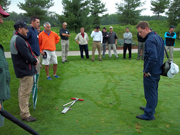
Features
Agronomy
USGA agronomist shares his findings during five-stop ‘Turf Academy’ series
October 9, 2012 By Mike Jiggens
USGA Green Section agronomist Adam Moeller returned to Ontario for a
second year in August to conduct a five-visit “Turf Academy” series,
sponsored by Plant Science.
Over a period of five consecutive days, he visited Leamington’s Erie Shores Golf Club, Waterloo’s Grey Silo Club, Toronto’s Weston Golf Club, Barrie’s National Pines Golf Club and Belleville’s Black Bear Ridge Golf Club.
Plant Science has conducted its Turf Academy series for several years. Up until last year, University of Michigan plant pathologist Dr. Joe Vargas had led the on-site tours which are intended to identify various problem areas on the golf courses visited and present solutions to correct them.
Moeller, who represents the USGA’s northeast region, specializes in issues related to aeration and topdressing, offering a change in direction from the Vargas-led course tours.
Not only was each course visited meant to offer an exchange of information with the host superintendent, but each visit attracted several other superintendents from neighbouring golf courses who were experiencing similar situations.
While at Grey Silo, Moeller noted he had seen a number of golf courses with abundant thatch levels, including that at Grey Silo. Superintendent Jeff Haynes said he aerates usually only once a year and light topdresses every three weeks. Moeller suggested that once yearly aeration and a topdressing schedule that falls short of an ideal every-other-week goal will ensure thatch is “not going to go anywhere. The biggest flaw with thatch is that it retains moisture and, then when it gets dry, it’s a dry sponge.”
Haynes said when he was able to topdress every couple of weeks, he managed to reduce his thatch “slightly.”
Moeller said if aeration can be done twice a year with tightened spacing, some improvements might be realized.
Abundant thatch, he said, makes it more difficult to achieve desired green speeds, and putting surfaces will stay wet and will be softer, leading to increased ball mark issues. Pesticide efficacy will also be reduced, and there is an increased potential for scalping.
Moeller recommended topdressing every two weeks at the longest and brushing in the sand within a half-hour to an hour after it is applied. He added the more thatch that exists, the greater the chances for scalping, especially if the mower is heavier than average.
Grey Silo was host to the Manulife Financial LPGA Classic in July. Green speeds of 11.5 were achieved at the outset of the tournament, but then increased as the final rounds were played.
Thatchy fairways can be intense to properly maintain, Moeller said, adding there is the danger they could become hydrophobic. More fairway topdressing and verticutting are required in such situations. Verticutting is more of a frequency vs. depth strategy, he said.
Fairway topdressing sand is cheaper than that required for greens and doesn’t need to meet the same specifications as long as its particles aren’t excessively large.
“To some extent you need the thatch because there’s just no soil,” Moeller said. “If you didn’t have some thatch, you’d see a lot of wear and tear on the edge, with your fiveplex mowers just digging in constantly because the plant’s just not going to be very strong.”
A balance between turfgrass health and golf playability must be struck, he said.
Bentgrass is not the most ideal variety for fairways on many courses, Moeller said.
“If you can’t commit to the right programs, it’s not going to play that great.”
Bentgrass is not the best for intermediate cuts, he said, because it’s not suited for heights exceeding a half-inch.
Moeller admitted the days of Monday course closures for maintenance purposes are long gone, but said it is feasible for public courses to block two hours of the first Monday of the month and to close the tee sheet at 3 p.m. on the third Monday so that morning maintenance can be jump started once a month, and afternoon or evening maintenance can be conducted on the other Monday.
“You get that two-week interval where you can verticut and topdress, spray, brush and groom and do what you need to do.”
The strategy prevents golfers from “breathing down the necks” of maintenance staff on every hole and promotes increased worker efficiency.
With less thatch, rolling is more effective, Moeller said.
“The more thatch you have, the less beneficial rolling becomes. It’s just like rolling over a mattress.”
Moeller said he prefers to see more rolling and less mowing, especially when grass is under stress.
Other host superintendents for the Turf Academy were:
• Mike Toth, Erie Shores
• Robert Ackermann, Weston
• Mike Powers, National Pines
• Bill Fach, Black Bear Ridge
Print this page